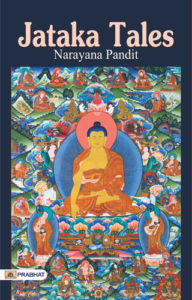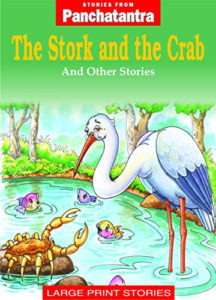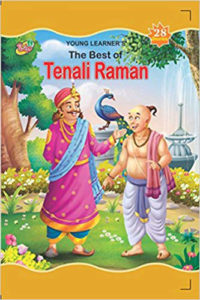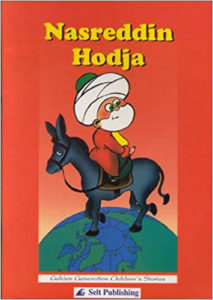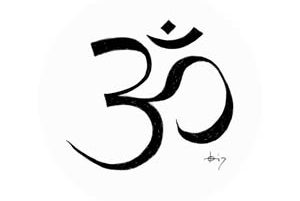Nivedita Yohana
QFWF, 2019-03
Whether it is to preserve history or to provide moral lessons, ancient folk tales have served a much bigger purpose than just entertaining people. Here are some famous and fascinating stories that have enlightened generations of Indians and continue to be a major source of education in realities of life. The stories are not just meant for a specific or certain age group; on the contrary it applies to all the age groups and to people coming from different walks of life. In no particular order of importance, here are the most popular legends that mould India and the Indians.
The Legend of Akbar and Birbal
Birbal or Raja Birbal, was a Hindu Brahmin advisor in the court of the Mughal emperor, Akbar. He is mostly known in the Indian subcontinent for the folk tales, which focus on his wit.
Birbal was appointed by Akbar as a minister “mantri” and used to be a poet and singer in around 1556–1562. He had a close association with Emperor Akbar and was one of his most important courtiers, part of a group called the navaratnas (nine jewels of Akbar).
By the end of Akbar’s reign, local folk tales emerged involving his interactions with Akbar, portraying him as being extremely clever and witty.
As the tales gained popularity in India, he became even more of a legendary figure across the Indian subcontinent. These tales involve him outsmarting rival courtiers and sometimes even Akbar, using only his intelligence and cunning, often with giving witty and humorous responses and impressing Akbar.
From the twentieth century onwards, plays, films and books based on these folk tales were made, some of these are in children’s comics and school textbooks.
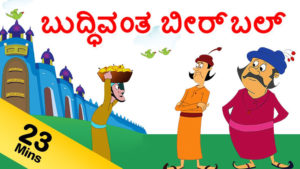
Birbal was known for his wit, and in time, tales about his astuteness spread far and wide. Stories about Birbal getting the better of jealous rival courtiers and his repartee with Akbar are loved by one and all in India.
Here’s one such tale about Birbal:
A line on the floor
One day Akbar drew a line on the floor with his hand. He then commanded everyone present make the line shorter without erasing any part of it.
One after another the courtiers tried to solve the puzzle, but no one could make sense of it.
However, it was soon Birbal’s turn and he just drew another longer line next to the first one. Thus, he made the line drawn by Akbar shorter without ever having touched it.
Akbar and his courtiers were once again forced to acknowledge Birbal’s unsurpassable wit.
Mythical and symbolical wisdom in the story
- In order to solve any problem, one needs to detach oneself from it and look at it from different perspectives so that creative solutions can be sought.
The legend of Vikram and Baital (devil)
The legendary king Vikramsditya (Vikrama) promises a vamachari (a sorcerer) that he will capture a Betala (or Baital), a celestial spirit “Pishacha”, celestial spirit analogous to a vampire in Western literature who hangs upside-down from a tree and inhabits and animates dead bodies.
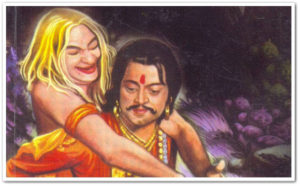
King Vikrama faces many difficulties in bringing the betala (the spirit) to the sorcerer. Each time Vikram tries to capture the betala, it tells a story that ends with a riddle. If Vikrama cannot answer the question correctly, the vampire consents to remain in captivity. If the king knows the answer but still keeps quiet, then his head shall burst into thousand pieces but if King Vikrama answers the question correctly, the vampire would escape and return to his tree. He knows the answer to every question; therefore the cycle of catching and releasing the vampire continues twenty-four times.
Baital Pachisi is believed to be one of the oldest vampire stories from India. King Vikram once promised a tantric sorcerer that he’d capture a baital (a spirit with vampire like qualities) and bring it to him. But every time Vikram caught the baital, the spirit would escape by posing a riddle. The deal between the two was that if at the end of every puzzle, Vikram was unable to answer the question correctly, the spirit would willingly be taken prisoner. If Vikram knew the answer but still stayed silent, his head would explode into a thousand pieces, and if the king answered correctly, the baital was free to get away.
This cycle continued 24 times as Vikram, being a wise man, could solve every riddle, which mostly concerned philosophical questions about life. Finally, Vikram was unable to answer the 25th question and the baital kept his promise of being taken captive.
One of the stories is as follows:
Washerman Dhavala
Once upon a time there lived a washerman named Dhavala. He once spotted a very beautiful lady at pond, who happened to be the daughter of another washerman.
He instantly fell in love with her and pleaded with his parents to ask her parents for her hand in marriage.
His parents did accordingly and the girl, Madanasundari, got married to him with her parents consent. She then went with Dhavala to live with him.
Once the brother of Madanasundari, came to Dhavala to invite his sister and brother-in-law to their place for festival season. Dhavala agreed and the three of them were returning to Madanasundari’s home.
On the way they happened to pass by the temple of Durga Devi, the all powerful goddess of power. Her brother wanted to pay a visit to the goddess, and went to the temple. But as soon as he came near the goddess, he wanted to make a massive sacrifice to the goddess. So saying he cut his head off for the goddess.
Madanasundari was worried and she then sent her husband to see what the matter was. On seeing the state of his brother-in-law, the husband was also moved deeply and he decided to offer his own head too to the goddess and cut his own head with his sword.
Madanasundari, after a long wait came and saw both her brother and husband lying on the ground and then decided to take her own life but asked the goddesss to get the same brother and husband in the next life.
The goddess was pleased and stopped her from dying and asked her to join their heads and bodies and then she granted them life.
In a hurry, Madanasundari, exchanged the heads of her brother and husband and was perplexed. Baital stops and asks King Vikram asks this question:
Who among the two is the husband of Madanasundari?
Vikram replies with a lot of thought,
“The body that carries her husband’s head is her husband. The head is the most important part of the human body, and the rest of the body is identified by the head.”
As soon as Vikram had finished his answer,Baital disappeared back to the tree as the answer was correct.
Finally the 25th time, when Vikrama failed to answer the riddle at the end of the story, . Baital decided to concede to Vikrama’s request and goes to the sorcerer.
Mythical and symbolical wisdom in the story
- Mind is the most important and the most powerful part of the body which influences the physical body.
Jataka Tales
The Jatakas are amongst the earliest Buddhist literature, with metrical analysis methods dating their average contents to around the 4th century BCE. The Mahāsāṃghika Caitika sects from the Andhra region took the Jatakas as canonical literature and are known to have rejected some of the Theravāda Jatakas which dated past the time of King Ashoka. The Caitikas claimed that their own Jatakas represented the original collection before the Buddhist tradition split into various lineages.
According to A. K. Warder, the Jatakas are the precursors to the various legendary biographies of the Buddha, which were composed at later dates. Although many Jatakas were written from an early period, which describe previous lives of the Buddha, very little biographical material about Gautama’s own life has been recorded. The Jatakas of Arya Sura in Sanskrit gives Jatakas stories. At the Ajanta Caves, Jataka scenes are inscribed with quotes from Arya Shura, with script datable to the sixth century. It had already been translated into Chinese in 434 CE. Borobudur contains depictions of all 34 Jatakas from Jataka Mala.
One extract from the Jataka Tales is as follows:
The Future Buddha as a Wise Judge
A woman, carrying her child, went to the future Buddha’s tank to wash. And having first bathed the child, she put on her upper garment and descended into the water to bathe herself.
Then a Yakshini, seeing the child, had a craving to eat it. And taking the form of a woman, she drew near, and asked the mother,
“Friend, this is a very pretty child. Is it one of yours?”
And when she was told it was, she asked if she might nurse it. And this being allowed, she nursed it a little, and then carried it off.
But when the mother saw this, she ran after her, and cried out,
“Where are you taking my child to?”
and caught hold of her.
The Yakshini boldly said,
“Where did you get the child from? It is mine!”
And so quarreling, they passed the door of the future Buddha’s Judgment Hall.
He heard the noise, sent for them, inquired into the matter, and asked them whether they would abide by his decision. And they agreed. Then he had a line drawn on the ground; and told the Yakshini to take hold of the child’s arms, and the mother to take hold of its legs; and said,
“The child shall be hers who drags him over the line.”
But as soon as they pulled at him, the mother, seeing how he suffered, grieved as if her heart would break. And letting him go, she stood there weeping.
Then the future Buddha asked the bystanders,
“Whose hearts are tender to babes? Those who have borne children, or those who have not?”
And they answered,
“Oh sire! The hearts of mothers are tender.”
Then he said,
“Who, think you, is the mother? She who has the child in her arms, or she who has let go?”
And they answered,
“She who has let go is the mother.”
And he said,
“Then do you all think that the other was the thief?”
And they answered,
“Sire! We cannot tell.”
And he said,
“Verily, this is a Yakshini, who took the child to eat it.”
And he replied,
“Because her eyes winked not, and were red, and she knew no fear, and had no pity, I knew it.”
And so saying, he demanded of the thief,
“Who are you?”
And she said,
“Lord! I am a Yakshini.”
And he asked,
“Why did you take away this child?”
And she said,
“I thought to eat him, Oh my Lord!”
And he rebuked her, saying,
“Oh foolish woman! For your former sins you have been born a Yakshini, and now do you still sin!”
And he laid a vow upon her to keep the Five Commandments, and let her go.
But the mother of the child exalted the future Buddha, and said,
“Oh my Lord! Oh great physician! May your life be long!”
And she went away, with her babe clasped to her bosom.
Mythical and symbolical wisdom in the story
- There is no greater love than the love of a Mother who is willing to sacrifice anything for your happiness. The true nature of love is such that it never hurts.
Another legend in India is Panchatantra
Panchatantra Stories and Their Origin. The Panchatantra is an ancient Indian collection of inter-related animal fables in Sanskrit verse and prose. The earliest recorded work, attributed to Vishnu Sharma, dates to about 300 BCE. The fables are likely much older, having been passed down generations orally.
One of the extract from the collection of Panchatantra Tales is the story of The Stork and the Crab.
The Stork and the Crab
Once upon a time, there lived a stork beside a pond who used to pick fishes from the pond and eat them. However, as he grew older, he found it difficult to catch a single fish.
In order to feed himself, he thought of a plan. He told the fish, frogs, and crabs that some men are planning to fill the pond and grow crops and that’s why there won’t be any fish in the pond.
He also told them how sad he felt about this and that he will miss them all.
The fish were sad and asked the stork to help them. The stork promised to take all of them to a bigger pond. However, he told them,
“As I am old, I can take only a few of you at one go.”
The stork would take the fishes to a rock, kill and eat them. Every time he was hungry, he would take a few of them to the rock and eat them.
There also lived a crab in the pond and he also wanted to go to the bigger pond too. The stork thought of eating the crab for a change and agreed on helping him. On the way, the crab asked the stork,
“Where is the big pond?”
The stork laughed and pointed to the rock, which was filled with fish bones. The crab realised that the stork would kill him, and so quickly thought of a plan to save himself.
He caught the stork’s neck and did not let it go until the stork died.
Mythical and symbolical wisdom in the story
- Always have a presence of mind and act quickly when in danger.
The Legend of Tenali Rama
Tenali Ramakrishna also known as Pandit Ramakrishna was a poet, scholar, thinker and a Special Advisor in the court of Sri Krishnadevaraya, who was an emperor of the Vijayanagara Empire who reigned from 1509–1529.
He is the third ruler of the Tuluva Dynasty in South India. He was a Telugu poet who hailed from what is now the Andhra Pradesh region, generally known for his wit and humour. Tenali Rama was noted for his brilliance and wit.
Tenali Ramakrishna’s great work Panduranga Mahatmyam is a Kāvya of high merit, remarkable for its sonorous dignity of phrasing, and is counted as one of the Pañcha Mahā Kāviyas (the Five Great poems) of Telugu literature. Tenali Ramakrishna attained the status of a folk hero when he was the court poet of Krishnadevaraya, but at the same time he composed serious works on religion. He was known for wit and wisdom.
One of the extracts of the stories from the collection of Tenali Rama is the:
Tenali Rama the Horse trainer
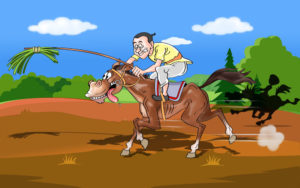
An Arab brought a shipload of horses from Persia. Many in the court of king Krishnadevaraya bought the horses from the Arab. Raman maintained that Vijayanagara’s horses were superior to the horses from Arabia.
The ministers who bought the Arabian horses challenged Raman to prove this point in a horse race.
The courtiers put in much effort to train their horses. They fed the horses well to make sure they were strong and sturdy.
On the day of the race, all the courtiers brought their well-fed horses to a field. They had employed well-trained jockeys to ride the horses.
Raman brought his horse which looked lean and thin. He had a hungry look, as though he had not eaten for days. Raman announced that he himself would ride his horse.
Raman sat on the hungry looking horse. He had a long pole in his hand. He had tied a bundle of grass to one end of the stick.
All the horses were lined up with the jockeys in position. Raman sat on the hungry looking horse. He had a long pole in his hand. He had tied a bundle of grass to one end of the stick. Holding the stick from the other end, Raman dangled the grass in front of the horse. The horse wanted to grab the food. So, he ran fast. But no matter how fast he ran, the grass remained outside his reach.
The horse kept running with greater speed until it crossed the finish line, coming first in the race. Raman hugged his horse and fed it lush green grass. When Raman went to collect the prize, the king asked him the secret of his success.
“One must have hunger for success, Maharaj,” Raman said, “only then will one succeed.”
Mythical and symbolical wisdom in the story
- One must have hunger for success, only then will one succeed. One will never give any excuses whatever the situation is.
The legend of Mullah Nasruddin or Nasreddin Hodja
Nasreddin Hoca (= Hodja in Turkish) was born in 1208 in Hortu village near town Sivrihisar (near Afyon) in the west part of Central Anatolia. He moved in 1237 to Aksehir town to study under notably scholars of the time as Seyid Mahmud Hayrani and Seyid Haci Ibrahim. He served as Kadi, Muslim judge, from time to time till 1284 which is the date of his death.
Nasreddin Hoca was a philosopher, wise, witty man with a good sense of humour. His stories have been told almost everywhere in the world, spread among the tribes of Turkic World and into Persian, Arabian, African and along the Silk Road to China and India cultures
He is known as Mullah Nasruddin in South Asian children’s books. A TV serial on him was aired in India as Mulla Nasiruddin and was widely watched in India and Pakistan.
Nasreddin stories are known throughout the Middle East and have touched cultures around the world. Superficially, most of the Nasreddin stories may be told as jokes or humorous anecdotes. They are told and retold endlessly in the teahouses and caravanserais of Asia and can be heard in homes and on the radio. But it is inherent in a Nasreddin story that it may be understood at many levels. There is the joke, followed by a moral and usually the little extra which brings the consciousness of the potential mystic a little further on the way to realization. ‘Mullah’ or ‘Hodja’ refers to the honorary rank- It is sometime preceded or followed by a title or honorific used in the corresponding cultures.
One of the tales of Mullah Nasruddin is:
The criticism of men
Hodja and his son went on a journey once. Hodja preferred that his son ride the donkey and that he himself go on foot.
On the way they met some people who said:
“Look at that healthy young boy! That is today’s youth for you. They have no respect for elders. He rides on the donkey and makes his poor father walk!”
When they had passed by these people the boy felt very ashamed and insisted that he walk and his father ride the donkey. So Hodja mounted the donkey and the boy walked at his side. A little later they met some other people who said:
“Well, look at that! That poor little boy has to walk while his father rides the donkey.”
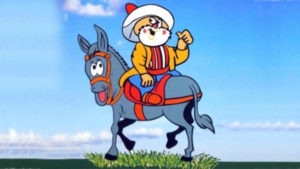
After they had passed by these people, Hodja told his son:
“The best thing to do is for both of us to walk. Then no one can complain.”
So they continued on their journey, both of them walking. A little ways down the road they met some others who said:
“Just take a look at those fools. Both of them are walking under this hot sun and neither of them are riding the donkey!”
Hodja turned to his son and said:
“That just goes to show how hard it is to escape the opinions of men.”
Mythical and symbolical wisdom in the story
- One can never escape from the opinions of people no matter what you do so it’s important to do the right thing in every situation immaterial of others opinion.
Thus the above mentioned stories which are popular in India are deeply entrenched in every Indian’s psyche. Since these stories are narrated and re-narrated to children and adults, the outlook towards life is influenced by these early exposures to multi-faceted perceptions toward life, the ancient wisdom based on experiences and humour.
Having said that, it depends on individual capacity to assimilate the essence of these stories and no two individuals comprehend things the same way nevertheless it certainly helps understand human emotions in its various hues and aids in building a foresight into real life’s situation and people. These stories rich with common sense, facilitates children to build discernment, judiciousness, shrewdness and astuteness.
The essence of these stories is such that it is applicable to all cultures, race and creed. It is not restricted to any one culture just because of its origins and that is the reason of its permanence. Human beings despite our individual upbringing based on our respective cultures, the essence of being a human remains the same which unites us all. These folk tales also have the quality of transcending time and space hence the term “ancient wisdom”.
Though these tales were written centuries ago, the fact that we are still writing about it, discussing it and even passing it over to the next generation speaks volumes about the inherent nature of human beings and the importance of this ancient wisdom for generations’ to come.
- Dongre, A., & Pai, A. (2005). Jataka tales: Nandivishala. Mumbai: India Book House.
- Kumāra, K.A. (n.d.). Vikrama Betāla kī rahasyamayī kahāniyām̐. Dillī: Manoja Pablikeśansa.
- Moseley, J. (2001). The ninth jewel of the Mughal crown: The Birbal tales from the oral traditions of India. Pasadena, CA: Summerwind Marketing.
- S., P.A. (1957). Tenali Rama. Madras: Orient Pub.
- Sherman, J. (2009). World folklore for storytellers: Tales of wonder, wisdom, fools, and heroes. Armonk, NY: Sharpe Reference.
- Soni, R. (1996). Mullah Nasruddin. Ahmedabad: Gurjar Granthratn.
- Subramaniam, N. (2005). Panchatantra. Chennai, India: Sura Books.
Notes
[1] Source: Akbar and Birbal
[2] Source: Vikram and Baital
[3] Source: Tenali Rama the Horse trainer
[4] Source: Nasreddin Hoca






